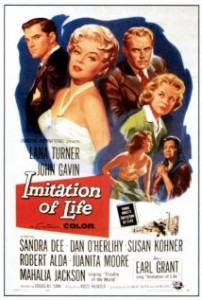Page to Screen: Imitation of Life (1959)
Yesterday I wrote about my impressions of the original 1934 version of the film Imitation of Life. Today I’m going to look at the 1959 remake of that film.
 The remake is quite different from the original in several ways. Bea’s character is now named Lora (Lana Turner) and is an aspiring actress in New York City. She meets Delilah’s character, now named Annie (Juanita Moore), at the beach on Coney Island. Annie and her daughter Sarah Jane have recently become homeless and Lora agrees to take them in just for the night. Lora is a single mother supporting her daughter Susie and she can’t afford to support Annie and Sarah Jane too. Annie gets a job washing shirts and she and her daughter end up staying. Eventually, Lora becomes a successful Broadway actress and is very wealthy. Annie’s role in Lora’s success is that she takes care of Susie while Lora is working. Lora works a lot so Annie is more of a mother to Susie than Lora is in most ways.
The remake is quite different from the original in several ways. Bea’s character is now named Lora (Lana Turner) and is an aspiring actress in New York City. She meets Delilah’s character, now named Annie (Juanita Moore), at the beach on Coney Island. Annie and her daughter Sarah Jane have recently become homeless and Lora agrees to take them in just for the night. Lora is a single mother supporting her daughter Susie and she can’t afford to support Annie and Sarah Jane too. Annie gets a job washing shirts and she and her daughter end up staying. Eventually, Lora becomes a successful Broadway actress and is very wealthy. Annie’s role in Lora’s success is that she takes care of Susie while Lora is working. Lora works a lot so Annie is more of a mother to Susie than Lora is in most ways.
Lora’s romance with Steve Archer (John Gavin) is fraught with conflict in this movie. He can only be with her if she prioritizes him over her work and apparently that means not working at all. He’s a good guy though; it’s clear that this expectation is not unreasonable. It’s Lora who is being unreasonable wanting to work when there is a perfectly good man wanting to take care of her. I wasn’t expecting to find such a sexist subplot – the 1930s version portrayed women in a way better and stronger light!
Sarah Jane’s struggle with being a light-skinned black person has a bigger part in this movie than Peola’s struggle in the original. I was disappointed that they did not cast a black person to play Sarah Jane. Susan Kohner did do a fabulous job playing Sarah Jane though and was nominated for both an Academy Award and Golden Globe for Best Supporting Actress for the role. Sarah Jane is even more of a “tragic mulatto” in this movie and has quite a few dramatic scenes in which she talks about why she wants to be white.
This movie address the issues of race in a more direct way than the original which I’m sure is a product of the time in which it was made. When Lora suggests that Annie talk to Sarah Jane about not trying to pass as white, Annie says, “How do you explain to your child that she was born to be hurt?” Like Delilah in the original movie, Annie wants a big funeral when she dies. She tells Lora to please invite all of Annie’s friends. Lora looks surprised and tells Annie that she didn’t know Annie had any friends besides her – very telling of the one-sided nature of their relationship.
Another difference between the two movies that I must note is the heightened drama in the remake. Lana Turner chews the scenery every chance she gets and the score is very heavy handed. The melodramatic background music makes sure that the viewer is not confused when something VERY DRAMATIC is happening.
This movie has all kinds of interesting movie star connections. Alan Alda’s dad, Robert Alda, plays an agent. Troy Donahue, who was just starting out, has a small part as a real jerk – he was not dreamy at all in this movie. And Susan Kohler’s son is Chris Weitz, the director of The Twilight Saga: New Moon.
It was interesting to watch the two versions of Imitation of Life back to back and see how much (and how little) relationships between black people and white people changed over the twenty-five years between the two movies.
Buy this movie at:
Amazon Instant Video




